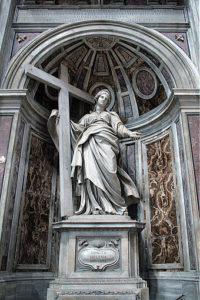St Helena
The conversion of the pagan Roman Empire to Christianity is one of the most interesting and consequential tales in history and part of it can be explained by the politics of marriage and succession.
In the third century the Empire was wracked by constant civil war with dozens of generals using their armies to attain the throne and killing more of their own citizens than barbarian enemies who were threatening the borders. To solve this problem, the soldier-emperor Diocletian (244-311) divided the empire into East and West, each to be ruled by an Augustus; he was Augustus of the East and his colleague Maximian became Augustus of the West. Each of the halves was further divided into two and a junior emperor or Caesar was appointed to share rule with the Augustus. This was known as the “rule of the four” or tetrarchy. Each had his own capital close to a threatened border (the city of Rome was now a political backwater). It was expected that in due time the Augustus would retire and appoint his Caesar in his place, thus ending the round of civil wars by providing an assured succession. To restore the good old days of the pagan Empire, a wide-spread persecution of Christians was ordered.
The Caesar in the West was Constantius Chlorus (250-306) who was less enthusiastic about persecuting the Christian church, possibly because his first wife (or concubine) was Helena, a Christian convert. Constantius had dumped Helena in 289 in order to make a politically-advantageous match with the daughter of Maximian but continued to favour their son Constantine. When Constantius died Constantine made a play for power and achieved supremacy in the West in 312 at the Battle of the Milvian Bridge. He issued a decree of religious toleration and Helena was brought out of retirement and treated as an Augusta or Empress.
Her Christianity was evident in her lifestyle. She toured the Holy Land and identified a number of the sites associated with the life of Jesus, sites on which the government of Constantine built the Church of the Nativity and the Church of the Holy Sepulchre. She brought back to Italy pieces of the True Cross on which Jesus had been crucified, the rope which had bound him, His tunic, nails used in the crucifixion, and earth from Golgotha, as well as the bodies of the three Wise Men. She is considered a saint in both the Eastern and Western Churches, the patron of archaeologists, difficult marriages, the divorced and nail-makers. Though she was buried in Rome, parts of her body were stolen by a devoted French monk in 840. After several other adventures this bit was entrusted to the Knights of the Holy Sepulchre and installed in their church, Saint-Leu-Saint-Gilles. These days, most Catholics in Paris have forgotten about the relics but they continue to be venerated by the Russian Orthodox community. Her head somehow managed to end up in a reliquary in Triers.
